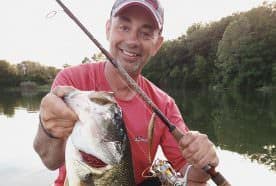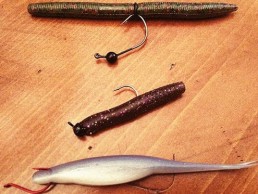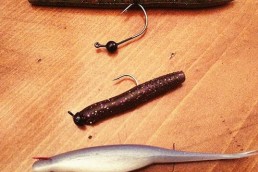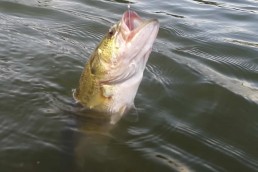Three Light-lining Methods to Catch Big Bass
SHARE THIS POST
Years ago when I fished bass tournaments I did my best to learn more about every technique that I read about. I would dive into every article I could find about jigging, crankbaiting, topwater tactics, etc. Near the end of my tournament days, I started reading about light-line fishing. It was not new, but back then hardly anyone was doing it. Small baits and light line were not the way (as far as I was concerned) that you caught big bass. I started reading more and more articles about wacky worming, drop-shotting, split shot rigging and shaky-head fishing. I learned how to do all of those, and I not only started catching more fish, but more big ones.
I want to go over some of my favorites, old and new. If you’re a bass fisherman and you still think light line is for amateurs, think again. When the water is clear you will continue to get your backside handed to you on a platter if you continue to be close-minded. If you’re a guy who simply wants to catch more fish, read on and you will have more tools to do just that.

Wacky worm
I rarely fish clear water without rigging up a wacky worm. Wacky worming is extremely effective for all species and all sizes of bass. One of the downsides of the technique is that if it’s windy, it can be hard to fish the lure much less control its decent or know exactly what depth it’s in. Several years back I came across the XPS Tungsten Wacky Jig Head. It’s an offset weighted hook that I slip through the “O” ring that I rig on the wacky worm. The weighted part is rigged so it faces the thick part of the wacky worm. It will ride underneath the worm on the fall and is strange to look at when first rigged. However, as it falls it causes the wacky worm to shake with more action than a standard rigged wacky. It also allows you to feel the setup as it sinks, even in windy conditions. On fluorocarbon line you can fish it at greater depths and with greater control. The bite is literally like a heavy weight or “pulling” sensation. Simply pulling back on the exposed hook gets you a proper hook-set.
Ned rig
Without question, one of the strangest do-nothing techniques on the market today is fishing the “Ned Rig.” It consists of a 2 3/4-inch worm. Rigged on a mushroom head, this small presentation has been the rage of the light-line world the last two years. Perfected by Z-Man, the Ned Rig is fished on 4- to 8-pound-test. I like fishing it on 10-pound Sufix Nanobraid with an 8-pound-test fluorocarbon leader and 6-foot 6-inch light- to medium-light-action rod such as the Abu Garcia Veritas. Swimming the lure just off the bottom with a slow retrieve, deadstick-dragging or with hop-N-drops can all be effective depending on water temperature and fish activity levels. Due to the small hook size on the mushroom head, simply pulling back on the strike with the light-action rod is truly all you will need—this is one of the best techniques to get a bite, and one of the best presentations to master for consistency. Learn this technique my friends, and you will be glad you did. It is extremely deadly on both active and inactive fish in clear to slightly-stained water.
Are you enjoying this post?
You can be among the first to get the latest info on where to go, what to use and how to use it!
Nose-rigged soft plastic jerkbaits
I have always loved to fish soft plastic jerkbaits for bass and other species, but learning how to nose-hook a soft plastic jerkbait has not only increased the number of fish I have caught, but last summer it led to a 7-pound largemouth—my biggest on a soft plastic jerkbait. I mentioned Sufix’s Nanobraid above, and it is the farthest-casting line on a spinning reel I have ever used. I always connect it to a fluorocarbon leader via an Albright knot and then use a 1/0 VMC Octopus hook which I insert through the nose on my jerkbait of choice. The VMC Octopus is also my choice for wacky worming. The 3- degree turn out on this hook creates a positive hook-set due to the rotation of the hook on it. I nose-hook the soft jerkbait because it allows more subtle action from the jerkbait compared to Texas rigging a jerkbait with a much larger hook, which obviously works, but this rigging option has created more strikes for me.
Light-line fishing matched with the proper water clarity is not only more effective in most situations, it will also put you in the position to receive more strikes and more opportunities.
I have always said, “Fishing is, always has been, and always will be a game of odds.” The more odds you put in your favor the better the chances are for your success. When you have clear to lightly-stained water, light-line techniques will get you more bites. The only thing that keeps you from learning is you. You want to catch more fish, then learn the benefits of light line for big bass.
MWO
SHARE THIS POST
Did you enjoy this post?
You can be among the first to get the latest info on where to go, what to use and how to use it!
Jim Crowley
Jim Crowley is the host of hookandhunttv.com. He is an accomplished angler who has fished in six different countries. He’s also a certified shotgun instructor and avid waterfowler. Email questions or comments to: jim@hookandhunttv.com.



